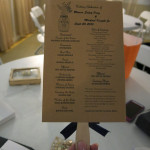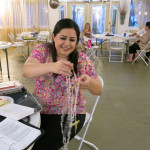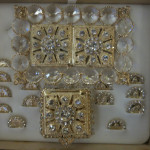Just recently I officiated at the wedding of a lovely couple who lives just outside of Charlottesville. The bride is of Mexican descent. The bride, groom and I worked to incorporate some beautiful and time-honored Mexican traditions in the Christian service. I share them with you here, hoping that you might want to use some Mexican traditions in your own wedding.

After the bride walked in to the service on her brother’s arm (her father is deceased) and was presented to her family, the groom’s family, and friends, I began the service proper with these words from Psalm 118: This is the day that the Lord has made, let us rejoice and be glad in it! I repeated that line in Spanish (Este is el dia que hizo Jehova nos gozaremos y alegraremos en el!) to recognize and honor the couple’s Spanish speaking guests.
When it came time for the vows, the bride and groom said them in English. However, I have sometimes officiated at weddings in which the bride or groom says her or his vows both in English and Spanish.
Next, the bride and groom exchanged rings.
Then came the ritual of the lazo. As is Mexican tradition, the mothers of the bride and groom came forward. The mother of the bride brought with her a decorative rosary, which the mothers put over the bride and groom’s heads. As they did this, I explained to the guests,

“_________(groom) and __________(bride) have chosen to incorporate the lazo ceremony into their wedding service today. ___________ and ____________will be bound together with a ceremonial rosary. This is a sign and symbol of their dedication to each other. The rosary will be draped across their shoulders by their mothers—note that the rosary will be looped to form of a figure eight, which is the symbol for eternity.
“___________(groom) and ___________(bride) , as you are bound together now, so too your lives and spirits are joined in a union of everlasting love and trust. Above you is the sun and below you is the earth. Like the sun, your love should be a constant source of light, and like the earth, a firm foundation from which to grow.”
At this point the mothers sat down and the bride’s brother came forward holding a tray. On that tray were highly decorative coins—13 in all The number thirteen represents Christ and the twelve apostles. The brother held the tray out to the groom as I said,
“Another tradition which may be familiar to many of you, is the giving of the arras. ____________(brother) will give thirteen gold coins to ___________(groom) who will in turn give them to _________(bride). The thirteen gold coins represent all the many values that the couple desires to share between them: love, harmony, cooperation, commitment, peace, happiness, trust, respect, caring, wisdom, joy, wholeness and nurturing. May these coins also be a symbol of __________(groom’s) and ________________(bride’s) mutual love, fidelity and trust.”

I then asked the groom to repeat after me: I, __________(groom) give you _________(bride) these 13 coins as a symbol of my unquestionable trust and confidence. As we unite our lives today, I pledge to share all my material possessions with you.”
The groom gave the coins to the bride. I then asked the bride to repeat after me:
“I, ___________(bride), accept these coins and assure you of my unconditional love for you and my dedication to care for you and all that we now possess.”
At this point, the brother took back the tray with the coins on them and the mothers came forward and removed the lazo so that we could continue with the service.
The service concluded with a heartfelt prayer. The gathering joined in asking God to bless these two people now united.
Hope this helps in planning your own wedding!
Yours Wedding Preacher for HIre
Leave a Reply